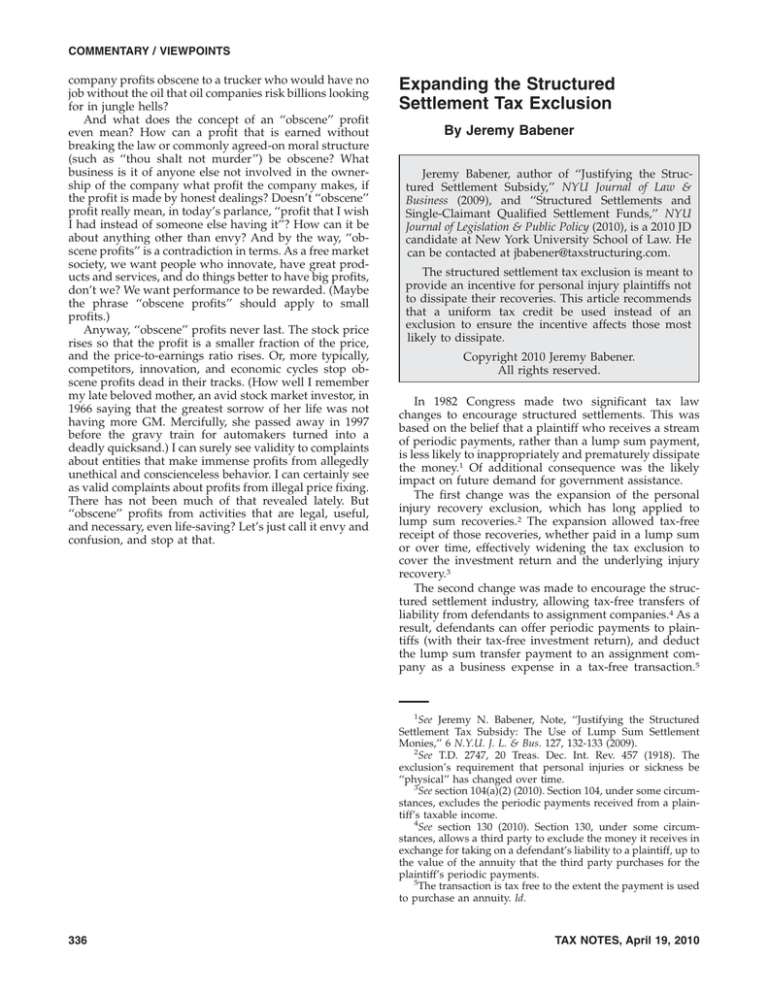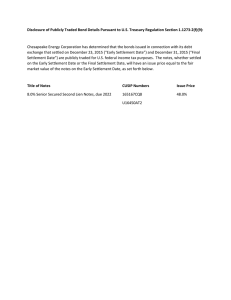Expanding the Structured
advertisement

COMMENTARY / VIEWPOINTS company profits obscene to a trucker who would have no job without the oil that oil companies risk billions looking for in jungle hells? And what does the concept of an ‘‘obscene’’ profit even mean? How can a profit that is earned without breaking the law or commonly agreed-on moral structure (such as ‘‘thou shalt not murder’’) be obscene? What business is it of anyone else not involved in the ownership of the company what profit the company makes, if the profit is made by honest dealings? Doesn’t ‘‘obscene’’ profit really mean, in today’s parlance, ‘‘profit that I wish I had instead of someone else having it’’? How can it be about anything other than envy? And by the way, ‘‘obscene profits’’ is a contradiction in terms. As a free market society, we want people who innovate, have great products and services, and do things better to have big profits, don’t we? We want performance to be rewarded. (Maybe the phrase ‘‘obscene profits’’ should apply to small profits.) Anyway, ‘‘obscene’’ profits never last. The stock price rises so that the profit is a smaller fraction of the price, and the price-to-earnings ratio rises. Or, more typically, competitors, innovation, and economic cycles stop obscene profits dead in their tracks. (How well I remember my late beloved mother, an avid stock market investor, in 1966 saying that the greatest sorrow of her life was not having more GM. Mercifully, she passed away in 1997 before the gravy train for automakers turned into a deadly quicksand.) I can surely see validity to complaints about entities that make immense profits from allegedly unethical and conscienceless behavior. I can certainly see as valid complaints about profits from illegal price fixing. There has not been much of that revealed lately. But ‘‘obscene’’ profits from activities that are legal, useful, and necessary, even life-saving? Let’s just call it envy and confusion, and stop at that. Expanding the Structured Settlement Tax Exclusion By Jeremy Babener Jeremy Babener, author of ‘‘Justifying the Structured Settlement Subsidy,’’ NYU Journal of Law & Business (2009), and ‘‘Structured Settlements and Single-Claimant Qualified Settlement Funds,’’ NYU Journal of Legislation & Public Policy (2010), is a 2010 JD candidate at New York University School of Law. He can be contacted at jbabener@taxstructuring.com. The structured settlement tax exclusion is meant to provide an incentive for personal injury plaintiffs not to dissipate their recoveries. This article recommends that a uniform tax credit be used instead of an exclusion to ensure the incentive affects those most likely to dissipate. Copyright 2010 Jeremy Babener. All rights reserved. In 1982 Congress made two significant tax law changes to encourage structured settlements. This was based on the belief that a plaintiff who receives a stream of periodic payments, rather than a lump sum payment, is less likely to inappropriately and prematurely dissipate the money.1 Of additional consequence was the likely impact on future demand for government assistance. The first change was the expansion of the personal injury recovery exclusion, which has long applied to lump sum recoveries.2 The expansion allowed tax-free receipt of those recoveries, whether paid in a lump sum or over time, effectively widening the tax exclusion to cover the investment return and the underlying injury recovery.3 The second change was made to encourage the structured settlement industry, allowing tax-free transfers of liability from defendants to assignment companies.4 As a result, defendants can offer periodic payments to plaintiffs (with their tax-free investment return), and deduct the lump sum transfer payment to an assignment company as a business expense in a tax-free transaction.5 1 See Jeremy N. Babener, Note, ‘‘Justifying the Structured Settlement Tax Subsidy: The Use of Lump Sum Settlement Monies,’’ 6 N.Y.U. J. L. & Bus. 127, 132-133 (2009). 2 See T.D. 2747, 20 Treas. Dec. Int. Rev. 457 (1918). The exclusion’s requirement that personal injuries or sickness be ‘‘physical’’ has changed over time. 3 See section 104(a)(2) (2010). Section 104, under some circumstances, excludes the periodic payments received from a plaintiff’s taxable income. 4 See section 130 (2010). Section 130, under some circumstances, allows a third party to exclude the money it receives in exchange for taking on a defendant’s liability to a plaintiff, up to the value of the annuity that the third party purchases for the plaintiff’s periodic payments. 5 The transaction is tax free to the extent the payment is used to purchase an annuity. Id. 336 TAX NOTES, April 19, 2010 COMMENTARY / VIEWPOINTS Together with the first change, Congress made it possible for plaintiffs to receive more from a settlement while defendants pay less. Congress has maintained both tax incentives since 1982, and there is little suggestion that it should change course. Yet it is unfortunate that the structured settlement recipient benefit takes the form of an exclusion. As a result, the system arguably least benefits those who need it most. A better and more equitable incentive could be achieved through a uniform refundable tax credit for structured settlement recipients. The Rationale for a Refundable Tax Credit The structured settlement recipient tax exclusion does not benefit all those eligible to make use of it. Like all exclusions, the recipient exclusion is of no value to persons who would not face income tax liability without it. Because of the United States’ progressive income tax rates, exclusions are most valuable to those with higher incomes, and least valuable to those with lower incomes. Because the structured settlement tax incentive takes the form of an exclusion, its benefit may have an inappropriate focus on the wrong group: higher-income earners. Public policy would support that incentive structure if it was clear that the action desired (that is, the agreement to a structured settlement) was particularly important for higher-income earners. In fact, the opposite may be true. Among the spectrum of all potential structured settlement recipients, who is most likely to prematurely and inappropriately dissipate a lump sum settlement? Those are the plaintiffs that the structured settlement incentive should target most. By doing so, the government would be getting the most bang for its buck.6 Even if the incentive does not disproportionately target that group, it should not overlook the group entirely. Through logic, inference, and experience, one might conclude that low-income earners are those most likely to quickly dissipate a lump sum settlement. Intuitively, it seems that many plaintiffs earn low incomes after a personal injury settlement because they are seriously injured and incapable of regular work. Those plaintiffs also have high medical expenses. We would expect the opposite to be true of those earning higher incomes after settlement; they are likely less injured, more capable of working, and incur less substantial medical expenses. Also, those earning high incomes before settlement may have other safeguards against early dissipation, such as experience with investments. 6 The cost in lost revenue is unknown. However, an estimate by the author, based on industry practitioner knowledge, puts it between $360 million and $830 million annually. Babener, supra note 1, at 131. TAX NOTES, April 19, 2010 Based on the inferences above, Congress might have chosen to target its structured settlement incentive on lower-income plaintiffs. However, without any empirical data on the subject, the economic literature suggests that it may be most efficient to incentivize plaintiffs in all income tax brackets equally.7 That could be done through a uniform tax credit, providing a fixed monetary incentive based on the investment portion of the structured settlement annuity received. Of course, the incentive could also take the form of an expenditure-side subsidy, but those have proven more difficult to enact.8 Either route could be done on a revenue-neutral basis, costing the government no more than the current incentive. Or, since the tax benefit will have a broader reach, the government might allow its cost to increase so that the incentive to each person or entity does not decrease. Simply stated, there seems to be no argument for targeting the structured settlement incentive on higherincome earners. Congress views structured settlements as useful for preventing dissipation and decreasing the likelihood of future assistance expenditures. Although no conclusive studies were performed before or since the enactment of the structured settlement incentives, their continued existence suggests that Congress believes that the cost to the government in lost revenue is justified by the increased take-up of structured settlements. There has been no explanation by any Congress member or association why the incentive should target those with greater tax liability. By expanding the incentive to influence those with lower incomes through a uniform refundable tax credit, Congress may better accomplish what it set out to do in 1982. It must be noted that such a dramatic change to the structured settlement tax incentive may not be practically possible. In truth, it is more of a ‘‘transformation’’ than an ‘‘expansion.’’ However, it is important for those in the industry and those legislating on the issue to realize how many potential structured settlement recipients do not receive more than a marginal benefit from the incentive. Even if a uniform tax credit is not possible, some form of monetary encouragement directed to those plaintiffs, whether in the form of a tax credit or otherwise, should be considered. 7 See Lily L. Batchelder, Fred T. Goldberg Jr., and Peter R. Orszag, ‘‘Efficiency and Tax Incentives: The Case for Refundable Tax Credits,’’ 59 Stan. L. Rev. 23, 28 (2006) (explaining that when evidence is inconclusive in determining whether responsiveness to a subsidy varies by income class, ‘‘uniform refundable credits minimize the expected deadweight loss remaining as a result of errors in the incentive’s structure’’). 8 Id. (citing Eugene Steuerle, ‘‘Tax Policy From 1990 to 2001,’’ in American Economic Policy in the 1990s 139, 154 (Jeffrey A. Frankel and Peter R. Orszag, eds., 2002)). 337






